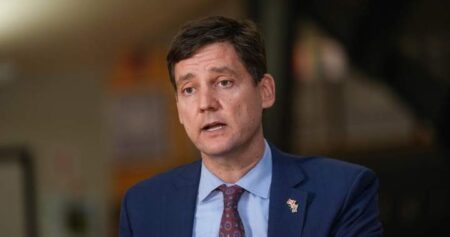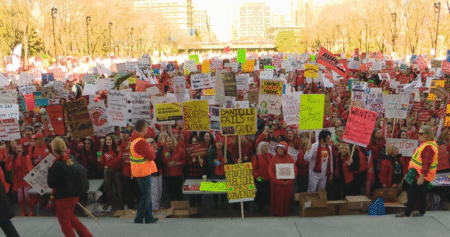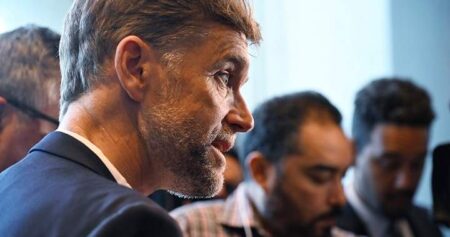The spectre of the Liberals’ 1995 budget cuts loom over public sector unions as Prime Minister Mark Carney prepares to introduce his first budget Tuesday.
The federal public service workforce has grown significantly over the last two decades under both Conservative and Liberal governments, and the number of federal bureaucrats is higher than its pre-pandemic peak.
Finance Minister François-Philippe Champagne, who will table the Carney government’s first budget on Tuesday, has suggested that the federal workforce numbers are not “sustainable.”
But federal union leaders who spoke to Global News say cutting the public service are pushing back, arguing job cuts are not the most efficient path the reining in the government’s operating budget.
“We’ve seen a pattern in the last year, the end of the (Justin) Trudeau government until now, where the resources and support public servants need to do their jobs properly are stripped away in the name of spending restraints … And as they strip away those resources and support, the public sector gets blamed for being ineffective,” said Nathan Prier, the president of the Canadian Association of Professional Employees, in an interview.
“And it’s Canadians who ultimately suffer the consequences.”
Under Trudeau, the Liberals enjoyed a period of relative labour peace after public sector unions battled with Stephen Harper’s Conservatives over spending reviews and job cuts. The Trudeau Liberals also enjoyed support from large private sector unions during their tenure.
That could change, Prier agreed, if the Carney government moves ahead aggressively with public sector cuts.
Full-time equivalent positions in the federal public service came in at roughly 441,000 in the 2023-24 fiscal year, up from the pre-pandemic peak of 382,000 in 2019-20 according to a recent report from the Parliamentary Budget Office.

Get breaking National news
For news impacting Canada and around the world, sign up for breaking news alerts delivered directly to you when they happen.
The term “full-time equivalents,” or FTEs, refer not to the actual number of people in the public service, but a calculation based on the assigned hours of work.
While federal departments expect the number of FTEs to decline to 415,000 in 2027-28, the PBO noted projections tend to be “revised upward,” meaning departments don’t always find the savings they anticipate in their planning reports.
Carney’s pitch to Canadian voters last April included messages around bringing federal spending under control, signaling restraint after years of Liberal deficit spending under Trudeau.
Conservative Leader Pierre Poilievre pledged before the election to cut the public service, arguing the federal bureaucracy had grown too much under the Trudeau Liberals. Poilievre lost his Ottawa-area riding – home to many public servants – in the resulting election.
Carney’s platform included a pledge to balance the federal operating budget by 2028, and to adjust “how (the government does) things, to make the best use of (Canada’s) talented public service and new technologies.” Carney also asked his ministers in July to present plans to cut departmental spending by 15 per cent over the coming three years.
Sharon DeSousa, the president of the Public Service Alliance of Canada (PSAC), worried Carney’s approach could lead to tens of thousands of public sector layoffs, which would hurt local economies as well as federal programs.
“There’s always savings, don’t get me wrong, there’s ways that you could do things better and more streamlined, but we can’t look at it from an overall cookie cutter approach,” DeSousa said.
“We have to look at every single department, the work that they do, and how to make sure that work continues to happen.”
Carney’s pick of Canada’s top bureaucrat, Michael Sabia – an experienced hand who has spent time at the highest levels of both the private and public sectors – did little to assuage those fears. Sabia, who previously served as the
deputy minister of Finance Canada during the Trudeau years, has publicly expressed his desire for cultural change in the public service.
Last month, Carney talked about finding savings in the public sector payroll through “attrition” – not filling positions left by workers seeking other opportunities or retiring.
But on Wednesday, Finance Minister François-Philippe Champagne said at a press conference that Canadians are facing “head winds” and have to be prepared for “tough choices.”
He explained that government processes need to be improved, better technology needs to be used, and some things will have to be merged. He said these changes would come with “workforce adjustments.”
“But you do that in a compassionate way, you do that in a fair way, you do that in a smart way. And I think that’s what Canadians expect from us and that’s what we’re going to deliver to Canada,” he said.
The departments that are expected to have the biggest job cuts are the CRA, Employment and Social Development, and Citizenship and Immigration, according to a recent analysis by the Canadian Centre for Policy Alternatives (CCPA).
Sean O’Reilly, the president of the Professional Institute of the Public Service of Canada (PIPSC), said his union has ideas about how the government can cut back on operational spending without cutting public servants from the workforce – but that the government has yet to consult with his organization.
“The services that our members provide, that all public servants provide, to Canadians is key to their health and safety, and their wellbeing. And my concern is any time there’s an effect on the public service, that affects the services to Canadians,” O’Riley said.
¬ÝWith a file from Global‚Äôs Jillian Piper and Grace Huntley.
© 2025 Global News, a division of Corus Entertainment Inc.
Read the full article here














